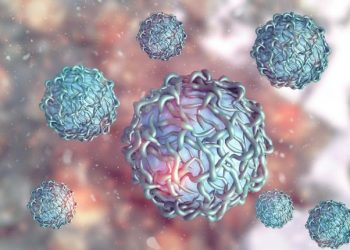Papillary thyroid cancer usually develops as a nodule on the thyroid gland. These nodules may be noticed by the patient or discovered during a physical exam or imaging tests done for other reasons.
Almost all people with papillary thyroid cancer have surgery (thyroidectomy). Many also take radioactive iodine therapy to kill any remaining cancer cells. There are a small number of variants of PTC that behave more aggressively and have higher rates of recurrence and metastasis than classic PTC.
Symptoms
Most often, papillary thyroid cancer (PTC) shows up as a painless lump or nodule on the thyroid gland. Sometimes it’s noticed by the person himself or herself, or a doctor might feel it when examining the neck during routine examination. Other times, it’s discovered by chance when someone gets a CT scan or an MRI for another reason.
These imaging tests help the doctor find out what the nodule is made of and whether it’s cancerous. The imaging studies can also help tell where the cancer is and whether it has spread (metastasized).
Doctors aren’t sure what causes papillary thyroid cancer. But they do know that certain factors raise a person’s risk. These include having a family history of thyroid cancer, radiation treatment of the neck for another condition when you were young, and some genetic conditions like Cowden syndrome, familial adenomatous polyposis or Gardner syndrome. PTC is more common in women under age 40, and it’s much less common in men.
If the nodule is found to be cancerous, your provider may want to take a small tissue sample, called a biopsy, from the nodule. This is done with a thin needle. The tissue is then looked at under a microscope to see if it contains cancer cells and what type of papillary thyroid cancer they are.
Because the lymph nodes around the thyroid and sides of the neck can be affected by papillary thyroid cancer, your doctor will probably want to do a positron emission tomography (PET) scan. During this test, you lie on a table while a camera takes pictures of your body. The images show areas of your body that take up more sugar than others. Cancerous lymph nodes will take up more sugar than normal lymph nodes.
If the cancer has not spread, you may be able to have surgery and receive thyroid hormone therapy right away. However, your healthcare team will want to monitor you closely with blood tests and an ultrasound exam of the neck once or twice a year. If the cancer does grow, you’ll need more treatment.
Diagnosis
Most papillary thyroid cancers are asymptomatic (they do not cause symptoms) when they are in their early stages. They are often discovered by chance when patients present to their primary care provider with a neck lump or nodule or if they have an imaging study done for another reason. They are a very common cancer and are more frequent in females and those with a family history of thyroid disease.
Papillary thyroid cancers are typically diagnosed with fine needle aspiration biopsy (FNA) in which a fine needle is used to sample cells from the tumor or nodule. This test is a safe and relatively easy procedure and most physicians are comfortable performing it. In addition to FNA, a thyroid ultrasound is commonly performed in order to better differentiate solid from cystic lesions and to identify calcifications. The ultrasound is also useful in assessing a nodule’s growth or change in size over time.
If a nodule is found to be malignant on FNA, radioactive iodine scans and/or a CT scan of the neck are often ordered. These tests are used to look for spread of the cancer either into nearby lymph nodes or to distant sites.
In general, the spread of papillary thyroid cancer is slow and the prognosis for a patient with PTC who does not have any distant metastases is excellent. This is because most of these cancers do not invade surrounding structures or blood vessels and most have a minimal growth rate.
If the cancer is unencapsulated and has a higher risk of coming back (recurrence), then patients should have follow up labs, USG of the neck, and thyroglobulin blood tests done every 6 months to a year. These patients may benefit from having a molecular test done to see whether their cancer has a BRAF V600E mutation. This genetic mutation can make the cancer more likely to spread to the lungs and bone. If this is found then patients should be considered for surgery. Patients will need to be seen by both an endocrinologist and a head and neck surgeon or radiation oncologist.
Treatment
The good news is that papillary thyroid cancer tends to grow slowly and is often curable. Most patients with papillary thyroid cancer live longer than 95% of adults who don’t have metastatic cancer (spread to the lungs or bones). The most common treatment for PTC is surgery, and this is most successful when the tumor is small.
In about 20% of cases, a recurrence of papillary thyroid cancer develops after surgery. This can be due to the original cancer growing again or spread of the disease from the thyroid gland to other organs. When this occurs, survival rates drop sharply.
Nodules are usually found by a doctor during a neck exam, or they may be discovered incidentally on imaging tests such as ultrasound or a CT or MRI scan for other reasons. A nodule is a lump or growth in the thyroid gland that is solid or filled with fluid. Nodules are very common and most people will have a few nodules in their life. They can be a nuisance and some are quite large, but most do not cause symptoms. Larger nodules, especially if they are growing and compressing surrounding structures such as the trachea or larynx, may lead to hoarseness or difficulty swallowing. They can also create pressure on nerves in the neck, and this may be painful.
Once a nodule is found, it can be tested for cancer cells by doing a fine needle aspiration (FNA). A tiny needle is used to remove a small amount of tissue from the nodule with a syringe. A doctor then looks at the sample under a microscope to see if there are any cancer cells present. This is the most common test for thyroid nodules and is very sensitive for detecting cancer cells in papillary thyroid cancer.
Most cases of papillary thyroid cancer can be treated successfully with surgery and radioactive iodine. In some cases, a mutation can be detected that makes the cancer less responsive to radioactive iodine, and this information may help determine the best treatment.
After surgery, most patients will need to have a regular blood test to check their thyroid hormone levels and to monitor the area for signs of recurrence. They will also need to have a radioactive iodine scan at least once a year for the rest of their life. These procedures are easy to do and are very effective at catching any recurrence of the disease before it is too late.
Prognosis
A majority of papillary thyroid cancers are cured with surgery. Patients should be referred to an experienced thyroid cancer surgeon from the start so they can have the highest possible chance of getting a good result from their treatment. A team of doctors should be involved, including an endocrinologist, a surgeon who performs thyroid surgeries on a daily basis, an oncologist, a radiation oncologist, and an internist who specializes in nuclear medicine.
PTC usually does not cause symptoms, and it is commonly discovered when patients or their physicians feel a lump or nodule in the neck. Because these masses are not symptomatic, it is hard to determine how long they have been growing. However, if the tumors enlarge, they can push on structures such as nerves and lymph nodes, leading to pain or difficulty swallowing. Larger nodules can also compress surrounding structures and produce hoarseness. In a small percentage of cases, the cancer can metastasize to the lung and bone.
If the patient has a very advanced tumor, it might be more difficult to remove surgically and it may be harder to get a complete cure. In those cases, a combination of radioactive iodine and external beam radiation might be used. This is called RAI ablation and involves swallowing a pill containing radioactive iodine that destroys any remaining thyroid cells. This therapy is usually very well tolerated and the recurrence rate decreases.
It is important for the patients to be examined regularly after the thyroid surgery so the doctor can look for signs that the cancer has recurred (e.g., rising thyroglobulin level, increasing neck nodule size on ultrasound, or an abnormal thyroid USG pattern). Patients with papillary thyroid cancer who have had surgery should have blood tests and a USG of the neck every 6–12 months for life.
There are currently experimental drugs being tested for the treatment of papillary thyroid cancer. These drugs — dabrafenib and trametinib — can shrink the size of some thyroid tumors that are inoperable for other reasons, and they have been shown to be very safe and effective for this type of cancer.









